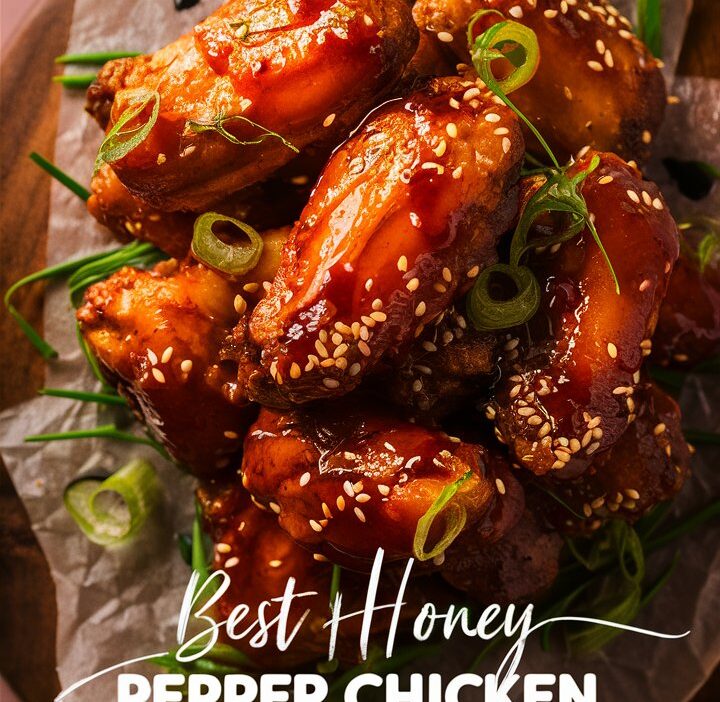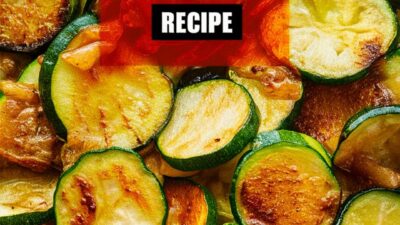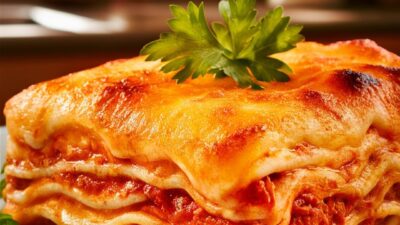Imagine a dish where tender chicken, glazed in a sweet-yet-spicy honey-pepper sauce, meets a luxuriously creamy macaroni and cheese. It’s a flavour journey: the crisp exterior of the chicken, the sticky sweetness of honey, the warm heat of pepper, and the rich melt of cheese coating every pasta twist. This recipe delivers comfort food with a bold twist. Whether you’re cooking for a family dinner, hosting friends, or simply treating yourself, this combination offers satisfaction in both taste and texture.
In this guide, we’ll cover everything: why the flavour works so well, ingredient selection, step-by-step instructions, tips for success, variations and adaptions (gluten-free, vegetarian, lighter versions), how to serve and store, and frequently asked questions. By the end, you’ll feel confident to create this dish from scratch — and perhaps even make it your signature.
Why This Dish Works: The Flavour & Texture Balance
The secret to this dish’s appeal lies in contrasts and balance:
- Sweet + Spice: The honey-pepper glaze brings sweetness that soothes, and heat that excites. The pepper (black pepper, cayenne or red-pepper flakes) adds a kick that keeps the palate alert.
- Creamy + Crispy: The macaroni and cheese delivers a smooth, creamy base; the glazed chicken adds a crisp edge and intense flavour.
- Comfort food with a twist: Macaroni and cheese alone is a classic comfort dish. By topping it with a glazed chicken, you elevate it — making it more substantial, more gourmet, yet still homey. (The combination is similar in spirit to what many copycat-restaurant recipes achieve. Tornadough Alli+2Recipes by Clare+2)
- Customisable: You can adjust the heat level, cheese blend, pasta shape, chicken preparation method, and side accompaniments — giving you flexibility depending on your audience or mood.
When you keep these flavour-texture principles in mind, you’re not just following a recipe — you’re building a dish that satisfies on multiple levels.
Ingredients: What You’ll Need
Here’s a well-rounded ingredient list (for about 4 servings) plus notes on why each is important and how to pick quality versions.
For the Honey-Pepper Chicken
- 3–4 boneless, skinless chicken breasts (or equivalent chicken tenders/strips). Choose fresh, firm chicken with minimal packaging liquid.
- Salt and freshly-ground black pepper: Simple but essential seasoning.
- ½ cup pure honey: Use a good-quality honey (not overly processed) for natural sweetness and depth.
- ¼ cup low-sodium soy sauce: Adds umami and salt balance, without making the dish overly salty.
- 1 teaspoon cayenne pepper (or less if you prefer mild heat). The cayenne provides the “pepper” in the honey-pepper theme.
- 4 cloves fresh garlic, minced: For aromatic depth and flavour.
- Optional: olive oil or a neutral oil (1–2 tbsp) if you’re pan-frying instead of baking.
For the Macaroni & Cheese
- 8 ounces (about 225 g) elbow macaroni (or any short pasta: cavatappi, shells, fusilli). Short shapes trap sauce best.
- 2 tablespoons unsalted butter.
- 2 tablespoons all-purpose flour. (Use this to build a roux and make a smooth cheese sauce base.)
- 2 cups whole milk (or a mix of milk + cream if you want extra richness).
- 2 cups shredded sharp cheddar cheese. Sharp cheddar = stronger flavour, good melt.
- ¼ cup grated Parmesan cheese (optional but adds nutty, salty flavour).
- Optional: Fresh basil or parsley for garnish; crispy bacon or breadcrumbs for topping; extra pepper flakes for heat.
Why these ingredients matter
- Chicken: Provides lean protein and texture contrast when glazed.
- Honey & soy sauce: Sweetness meets saltiness – a classic flavour pairing.
- Pepper/cayenne: Introduces heat, crucial for the “spicy” part of the dish.
- Cheese sauce base (butter + flour + milk + cheese): This is the classic method for a smooth, velvety cheese sauce — better than simply melting cheese into milk without structure.
- Short pasta shape: Ensures each bite picks up sauce.
- Quality components: Fresh garlic, good cheese, well-seasoned chicken – all enhance flavour significantly.
Step-by-Step Instructions
Here is a clear, optimised workflow so you can prepare this dish smoothly.
Step 1: Pre-prep & marinate
- Preheat the oven to 400 °F (about 200 °C) if you plan to bake the chicken. If you prefer pan-frying, heat the skillet accordingly.
- Season the chicken breasts generously with salt and fresh black pepper, then minced garlic and cayenne pepper (adjust heat to your preference).
- In a bowl, whisk together the honey, soy sauce, and an extra ½ teaspoon cayenne (or less) depending on your preferred spice level. Set this glaze aside.
- Optional: If you have time, marinate the chicken in half of the glaze for 30–60 minutes (or up to overnight) in the refrigerator. This helps deepen the flavour and ensures the glaze penetrates the meat.
Step 2: Cook the chicken
- If baking: Lightly spray a baking dish with non-stick spray or brush with oil. Place the chicken breasts in the dish, pour half of the glaze evenly over them, and bake for 25–30 minutes (or until the internal temperature reaches 165 °F / 74 °C).
- If pan-frying: Heat 1–2 tablespoons of oil in a skillet over medium-high heat. Add the seasoned chicken and cook ~6–8 minutes per side (depending on thickness) until cooked through. During the last 2 minutes, pour in the glaze and let it caramelise gently, turning the chicken to coat evenly.
Once cooked, remove the chicken and allow it to rest for a few minutes before slicing or serving. Reserve any extra glaze for drizzling.
Step 3: Cook the pasta
While the chicken is cooking (to optimise timing), bring a large pot of salted water to a boil. Add the pasta and cook according to package instructions until al dente — meaning still slightly firm under the tooth, as it will continue to absorb sauce. Drain and set aside.
Step 4: Make the cheese sauce
- In a medium saucepan over medium heat, melt the butter.
- Add the flour and whisk constantly for about 1–2 minutes, forming a roux (this cooks off the raw flour taste). Resist browning the roux – you want to keep it light for a smooth sauce.
- Slowly whisk in the milk, a little at a time, until smooth and starting to thicken.
- Reduce the heat to low, then gradually add the shredded cheddar cheese and Parmesan (if using), stirring consistently until fully melted and the sauce is smooth and velvety. Season lightly with salt and fresh pepper.
- Remove from heat.
Step 5: Combine pasta and sauce
Add the cooked (and drained) pasta into the cheese sauce and stir until the pasta is evenly coated. If you’d like to include extras (like crispy bacon bits, cooked vegetables, or breadcrumb topping), this is a good point to integrate them.
Step 6: Plate and assemble
- Plate a generous portion of the cheesy pasta.
- Place sliced chicken on top (or beside) and drizzle with remaining honey-pepper glaze.
- Garnish with fresh basil or parsley for a fresh herb accent. Optionally, add extra pepper flakes if you’d like more heat.
Step 7: Serve immediately
This dish is best enjoyed while it’s hot — the cheese sauce is at its creamiest and the glaze on the chicken is still glossy. Serve right away for the best experience.
Tips & Tricks for Best Results
Here are key pointers to elevate your dish from good to great:
- Use fresh ingredients: Fresh garlic, good-quality cheese, fresh chicken all make a difference in flavour.
- Marinate if possible: Even 30 minutes of marinating the chicken in the glaze helps build flavour deeply.
- Don’t overcook the chicken: Overcooked breast meat becomes dry. Use a meat thermometer if possible, and stop cooking once the internal temperature hits ~165 °F (74 °C).
- Achieve al dente pasta: Slightly firm pasta works better with cream sauces — avoid over-softening it in the pot.
- Build the cheese sauce properly: A mechanical base (butter-flour roux) ensures a smooth, stable sauce that doesn’t separate.
- Adjust spice carefully: Start modest with cayenne or pepper flakes and increase to taste. If you overshoot, add a splash of milk or a touch more cheese to mellow.
- Glaze timing matters: If pan-frying chicken and adding glaze at the end, allow the glaze to simmer briefly so it thickens and clings to the chicken rather than staying watery.
- Serve right away: Cheese-based sauces can thicken or separate if left too long; you get best texture when fresh.
- Leftover tip: If you have leftovers, store the chicken and pasta separately. When reheating the pasta, add a splash of milk and gently warm to restore creaminess. Reheat the chicken gently to preserve texture.
Variations & Customisations
One of the great things about this dish is its flexibility. Here are some adaptation ideas:
Lighter version
- Use grilled chicken instead of breaded or pan-fried.
- Use low-fat milk and reduced-fat cheese in the sauce.
- Add steamed vegetables (broccoli, spinach) to boost nutrition and lighten the plate.
Vegetarian version
- Replace chicken with roasted cauliflower or chickpeas glazed in the honey-pepper sauce.
- Use vegetable broth instead of chicken broth if you’re incorporating any stock.
- Use cheese sauce as described, or substitute a plant-based cheese for a vegan version.
Gluten-free version
- Use gluten-free pasta (rice, corn, or legume-based).
- Use a gluten-free flour blend or cornstarch slurry instead of all-purpose flour for the roux.
- Ensure the soy sauce is gluten-free (tamari is a good option).
- If coating chicken or veggies, use gluten-free breadcrumbs or almond flour.
Spicier version
- Increase cayenne pepper, add red-pepper flakes, or serve with a side of hot sauce.
- Add diced jalapeños or serrano peppers into the glaze or even into the cheese sauce for heat surprises.
Different cheese blends
- Swap in Gouda, Gruyère, or Fontina for different flavour profiles.
- For a smoky twist, use smoked cheddar or add smoked paprika to the cheese sauce.
Baking variation
- After combining pasta and cheese sauce, transfer to a baking dish, top with breadcrumb-cheese mixture, and bake at 375 °F (190 °C) for 15–20 minutes until golden and bubbly. Then top with the glazed chicken just before serving.
Serving Suggestions & Pairings
Here are ideas to round out your meal and elevate presentation:
- Side dishes: A crisp green salad (mixed leaves, vinaigrette) complements the richness. Steamed green beans or sautéed spinach add colour and freshness.
- Bread: Serve with a crusty garlic bread or soft dinner rolls to mop up any extra sauce.
- Drinks: A chilled white wine (e.g., Sauvignon Blanc or Chardonnay) pairs nicely with creamy cheese. For non-alcoholic, consider sparkling water with lemon or an iced tea with a citrus twist.
- Garnishes: Fresh basil leaves, parsley, a sprinkle of chopped chives or scallions add visual appeal and freshness. A little extra cracked black pepper on top emphasises the “pepper” theme.
- Presentation tip: For each plate, place the pasta in a slight mound in the centre, slice the chicken and fan it on top at an angle, drizzle extra glaze in a zigzag pattern, and finish with a fresh herb sprig.
Storage & Make-Ahead
- Make ahead: You can marinate the chicken a few hours or even overnight. You can also prepare the cheese sauce ahead of time, refrigerate it, then re-warm gently while you cook the pasta and chicken.
- Storage: Once cooled, store leftovers in an airtight container in the refrigerator for up to 3 days.
- Reheating: For the pasta, add a splash of milk and warm gently over low heat to restore creaminess. For chicken, reheat gently so the glaze doesn’t burn or the meat dry out.
- Freezing?: Freezing the fully assembled dish is not ideal, because cheese sauces often change texture when frozen and reheated. If you must, freeze the chicken and pasta & sauce separately; thaw and combine when ready to serve.
Frequently Asked Questions (FAQs)
Here are common questions and helpful answers about this dish.
What type of pasta works best?
Short pasta shapes like elbow macaroni, cavatappi, shells, or fusilli are ideal because they hold onto the cheese sauce and ensure each bite is coating with flavour. Recipes Culture+1
Can I use pre-cooked or leftover chicken?
Yes — if you use pre-cooked chicken, simply reheat and toss in the honey-pepper glaze so it gets that sweet-spicy coating. Freshly cooked chicken will, however, offer the best texture and flavour.
How can I reduce the spice for kids or sensitive eaters?
Reduce or omit cayenne pepper and red pepper flakes in the glaze. Increase the honey slightly to favour sweetness. Serve extra glaze on the side so individuals can add heat if they like.
Is it possible to make this dish vegetarian?
Absolutely — substitute roasted veggies or glazed tofu/tempeh for the chicken, and proceed with the cheese sauce and pasta as usual. Consider vegetable broth or plant-based milk/cheese to make it fully vegetarian or even vegan (using dairy-free cheese alternatives).
How can I make this dish healthier?
- Grill or bake the chicken rather than frying or heavy pan-frying.
- Use reduced-fat milk and cheese.
- Increase vegetable content (spinach, steamed broccoli mixed into the pasta).
- Skip or reduce bacon if using.
- Serve smaller portions of pasta and larger side salad/veg to balance the richness.
Why did my cheese sauce become grainy or separate?
Common reasons: the heat was too high, cheese was added too quickly, or the roux wasn’t cooked properly. To avoid this: use medium heat, add cheese gradually, stir continuously, and ensure the roux (butter + flour) was cooked briefly before adding milk. Recipes Culture
Final Thoughts
In the world of comfort food, this Sweet & Spicy Honey-Pepper Chicken with Creamy Macaroni & Cheese bridges indulgence and practicality. It’s bold in flavour yet approachable for home cooking. By mastering the key components — a balanced honey-pepper glaze, a smooth cheese sauce, and well-seasoned chicken — you’re delivering more than just a meal: you’re offering an experience.
Whether you’re cooking for your family, entertaining friends, or simply craving something satisfying, this dish ticks all the boxes: sweet, spicy, creamy, comforting, and customisable. Use the guidance above, adapt where needed, and enjoy the process of creating something memorable in your kitchen.




